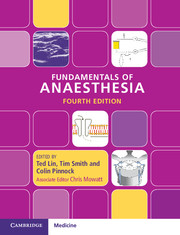Book contents
- Fundamentals of Anaesthesia
- Fundamentals of Anaesthesia
- Copyright page
- Dedication
- Contents
- Contributors
- Preface to the first edition
- Preface to the second edition
- Preface to the third edition
- Preface to the fourth edition
- Acknowledgements
- Abbreviations
- Section 1 Clinical anaesthesia
- Chapter 1 Preoperative management
- Chapter 2 Conduct of anaesthesia
- Chapter 3 Intraoperative management
- Chapter 4 Postoperative management
- Chapter 5 Special patient circumstances
- Chapter 6 The surgical insult
- Chapter 7 Regional anaesthesia
- Chapter 8 Principles of resuscitation
- Chapter 9 Major trauma
- Section 2 Physiology
- Section 3 Pharmacology
- Section 4 Physics and clinical measurement
- Index
- References
Chapter 1 - Preoperative management
from Section 1 - Clinical anaesthesia
Published online by Cambridge University Press: 19 January 2017
- Fundamentals of Anaesthesia
- Fundamentals of Anaesthesia
- Copyright page
- Dedication
- Contents
- Contributors
- Preface to the first edition
- Preface to the second edition
- Preface to the third edition
- Preface to the fourth edition
- Acknowledgements
- Abbreviations
- Section 1 Clinical anaesthesia
- Chapter 1 Preoperative management
- Chapter 2 Conduct of anaesthesia
- Chapter 3 Intraoperative management
- Chapter 4 Postoperative management
- Chapter 5 Special patient circumstances
- Chapter 6 The surgical insult
- Chapter 7 Regional anaesthesia
- Chapter 8 Principles of resuscitation
- Chapter 9 Major trauma
- Section 2 Physiology
- Section 3 Pharmacology
- Section 4 Physics and clinical measurement
- Index
- References
Summary
The safe conduct of anaesthesia requires meticulous preoperative assessment, preparation and planning. In the case of elective procedures this should occur well in advance of surgery, allowing a comprehensive review of concurrent disease, medication and social issues. This is often carried out in a dedicated preoperative assessment clinic by a multidisciplinary team comprising nursing and medical staff as well as pharmacists and specialist technicians.
- Type
- Chapter
- Information
- Fundamentals of Anaesthesia , pp. 1 - 28Publisher: Cambridge University PressPrint publication year: 2016



